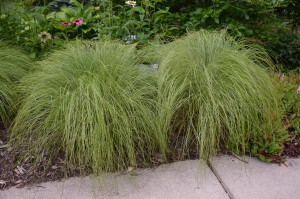‘Silk Tassel’ Japanese sedge (Carex morrowii var. temnolepis) is an ornamental sedge from Japan (USDA hardiness zones 5 to 9). It is grown in shady areas for its narrow, variegated foliage. It grows slowly as a dense, grass-like clump to 12 -15 inches high and up to 2 feet spread.
Foliage bubbles up like a shimmering water fountain of fine-textured variegated foliage. Silk Tassel has ultra narrow, 1/8 inch wide thread-like leaves. Fine-textured leaves spill out over the ground. It has a soft, flowing, iridescent look and at first glance, may appear to be a sparkling, silvery green mound. A silvery white stripe at center with dark green margins runs the length of the narrow blade. Tiny greenish-brown flower spikes appear in mid-spring and are inconspicuous, supported on triangular stems. Silk Tassel is evergreen in the deep South.
Silk Tassel offers a great accent for patios and decks in decorative containers, or plant close together in masses. It looks super planted in a rock garden, perhaps nearby a dark igneous rock. It is easily grown in moist, moderately acidic, well-drained soils in partial day sunlight, preferably in morning or dappled light. Soil moisture is key, not too much(soupy) and never too dry.
Mix this fine textured beauty with bold leaf perennials such as hostas, lungworts (Pulmonaria spp.), brunneras (Brunnera) and other broad-leaved shade loving perennials.
Sedges may occasionally be troubled by aphids, and soil borne diseases such as Rhizoctonia. Deer leave most sedges alone.
Silk Tassel was introduced and named by Barry Yinger who brought it from Japan almost 30 years ago. It is primarily sold by mail order nurseries.


 Posted in
Posted in 
